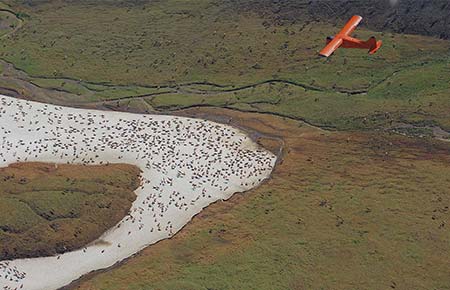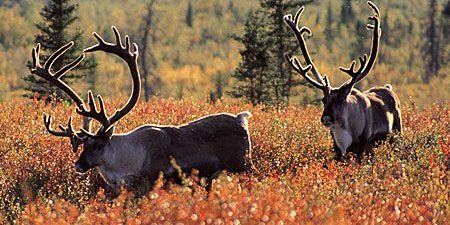Caribou users in the Northwest Arctic Borough were told Wednesday that North America’s largest herd declined by more than a quarter in just two years.
“The herd size right now, as of 2013, was 235,000 caribou, and that’s down about 27 percent since 2011—so, a real big decline in the last two years,” said Jim Dau, a wildlife biologist with the Alaska Department of Fish and Game.
Dau spoke at the Unit 23 Working Group’s annual meeting in Kotzebue Wednesday about what’s driving the herd’s sudden decline.
“Based on what we’ve seen we think winter events, especially during winter—these winter thaws with rain and ice, that probably started the herd down,” Dau explained. “When the herd started down we had increasing numbers of wolves and bears. Everybody from the villages [is] saying ‘lots of wolves, lots of wolves’—that’s what I see.”

Unit 23 includes all the hunting grounds in the Northwest Arctic Borough. The working group came about years ago as a way to ease worsening relations between caribou users.
“The Unit 23 working group was formed in 2008 to try to address conflicts between local and non-local hunters that were coming to the region to hunt,” said Jan Caufield, who has moderated the group’s meetings since the beginning.
Caufield said her job has gotten a lot easier of late. Now the group acts more like a lobby on issues facing caribou, such as the proposed Ambler road.
“One of the main interests of the working group in the proposed road project is just any impacts that it might have on the caribou herd, impacts it might have on how people access the area that might impact the number of hunters that come or the areas they can go,” Caufield said.

After a short break, two speakers from the Alaska Industrial Development and Export Authority, AIDEA, presented on the status of a potential road to the Ambler Mining District.
“We wouldn’t build the road unless we had a financial model that worked,” said Mark Davis, a deputy director for AIDEA.
“So we are developing estimates. And this road is probably going to be in the range of $200-$300 million. What we do at AIDEA is, we develop economic models–we will run models to make sure this can be paid back. AIDEA by statute has to make a return, and AIDEA–by statute–does not make grants.”
Davis said the agency is getting permit applications together in the next few months. Throughout the meeting, however, AIDEA presenters were upfront that there will not be firm answers available on environmental impacts, jobs, cost of living reductions, or effects to subsistence before more data is gathered for reports.
Maryellen Tuttell was the other presenter with AIDEA. She works for Dowl HKM, a private company with experience building and consulting on roads in Alaska.
“We believe that it has been demonstrated in Alaska that you can build a road and still maintain a healthy populations of subsistence resources,” Tuttell said, responding to a question on potential costs to wildlife. “So that’s our goal, is to work with the communities and the agencies to design a road that has a minimal impact.”
AIDEA has a community meeting scheduled for June 2 in Kobuk. The Unit 23 working group continues its meetings with state and federal agencies Thursday in Borough Chambers.







